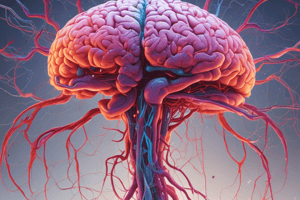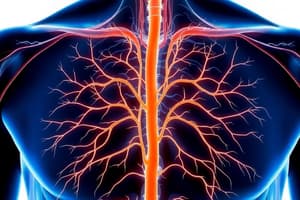Podcast
Questions and Answers
Quel lobe cérébral est délimité par le sillon circulaire de l'insula ?
Quel lobe cérébral est délimité par le sillon circulaire de l'insula ?
- Lobe de l'insula (correct)
- Lobe temporal
- Lobe occipital
- Lobe frontal
Quel sillon délimite le lobe cingulaire ?
Quel sillon délimite le lobe cingulaire ?
- Sillon intrapariétal
- Sillon précentral
- Sillon cingulaire (correct)
- Sillon postcentral
Les gyrus sont nommés selon leur localisation frontale par quelles désignations ?
Les gyrus sont nommés selon leur localisation frontale par quelles désignations ?
- F1, F2, F3 (correct)
- O1, O2, O3
- P1, P2, P3
- T1, T2, T3
Quel est le rôle des sillons secondaires dans le cerveau ?
Quel est le rôle des sillons secondaires dans le cerveau ?
Quel lobe est limité par le sillon pariéto-occipital ?
Quel lobe est limité par le sillon pariéto-occipital ?
Quel gyrus est associé au sillon postcentral ?
Quel gyrus est associé au sillon postcentral ?
Quelles sont les désignations des gyrus temporaux ?
Quelles sont les désignations des gyrus temporaux ?
Quel est l'effet principal des sillons sur la surface corticale ?
Quel est l'effet principal des sillons sur la surface corticale ?
Quelle structure reçoit la projection de l’hémichamp visuel controlatéral?
Quelle structure reçoit la projection de l’hémichamp visuel controlatéral?
Quelle est la fonction principale de l'oculomotricité extrinsèque?
Quelle est la fonction principale de l'oculomotricité extrinsèque?
Où se projettent les neurones des radiations optiques?
Où se projettent les neurones des radiations optiques?
Quelle structure est responsable des réflexes d’accommodation à la lumière et à la distance?
Quelle structure est responsable des réflexes d’accommodation à la lumière et à la distance?
Qu'est-ce qui ne fait pas partie de l'oculomotricité?
Qu'est-ce qui ne fait pas partie de l'oculomotricité?
Quel est le rôle principal du nerf vague après avoir quitté la moelle allongée ?
Quel est le rôle principal du nerf vague après avoir quitté la moelle allongée ?
Dans quelle région le nerf vague traverse-t-il le diaphragme ?
Dans quelle région le nerf vague traverse-t-il le diaphragme ?
Quel vaisseau accompagne le nerf vague lors de son trajet dans la gaine vasculaire ?
Quel vaisseau accompagne le nerf vague lors de son trajet dans la gaine vasculaire ?
Quel nerf est associé au muscle sternocléidomastoïdien ?
Quel nerf est associé au muscle sternocléidomastoïdien ?
Quel organe ne fait pas directement partie du trajet du nerf vague dans le cou ?
Quel organe ne fait pas directement partie du trajet du nerf vague dans le cou ?
Quel nerf est fréquemment associé au nerf vague dans la traversée du foramen jugulaire ?
Quel nerf est fréquemment associé au nerf vague dans la traversée du foramen jugulaire ?
Comment le nerf vague change-t-il de caractère après avoir atteint l'abdomen ?
Comment le nerf vague change-t-il de caractère après avoir atteint l'abdomen ?
Quel gyrus est spécifiquement mentionné comme ayant un nom particulier ?
Quel gyrus est spécifiquement mentionné comme ayant un nom particulier ?
Quelle est la relation du nerf laryngé récurrent par rapport au nerf vague ?
Quelle est la relation du nerf laryngé récurrent par rapport au nerf vague ?
Combien de gyrus composent l'insula et quel est leur agencement ?
Combien de gyrus composent l'insula et quel est leur agencement ?
Quel sillon est situé entre le gyrus cingulaire et le précuneus ?
Quel sillon est situé entre le gyrus cingulaire et le précuneus ?
Quel sillon est impliqué dans la variation de la forme des gyrus ?
Quel sillon est impliqué dans la variation de la forme des gyrus ?
Quelle méthode peut être nécessaire pour identifier les gyrus de manière précise ?
Quelle méthode peut être nécessaire pour identifier les gyrus de manière précise ?
Quel sillon se trouve au centre de l'insula ?
Quel sillon se trouve au centre de l'insula ?
Quel sillon est spécifiquement lié à la région pariétale ?
Quel sillon est spécifiquement lié à la région pariétale ?
Quelle partie du cerveau le gyrus parahippocampal est-il associé à ?
Quelle partie du cerveau le gyrus parahippocampal est-il associé à ?
Quel est le rôle principal des tonsilles cérébelleuses dans le contexte d'un hématome cérébelleux?
Quel est le rôle principal des tonsilles cérébelleuses dans le contexte d'un hématome cérébelleux?
Où se situe la moelle spinale par rapport au foramen magnum?
Où se situe la moelle spinale par rapport au foramen magnum?
Quelles structures sont présentes dans le canal vertébral caudalement à L1-L2?
Quelles structures sont présentes dans le canal vertébral caudalement à L1-L2?
Quelle partie de la moelle spinale est responsable des fonctions sensitives?
Quelle partie de la moelle spinale est responsable des fonctions sensitives?
Quelle est la composition de la substance dans la moelle spinale?
Quelle est la composition de la substance dans la moelle spinale?
Qu'est-ce qui assure la vascularisation artérielle de la moelle spinale?
Qu'est-ce qui assure la vascularisation artérielle de la moelle spinale?
Quelles sont les conséquences possibles à l'étage thoracolombal en termes de vascularisation?
Quelles sont les conséquences possibles à l'étage thoracolombal en termes de vascularisation?
Comment se présentent les nerfs spinaux par rapport à la moelle spinale?
Comment se présentent les nerfs spinaux par rapport à la moelle spinale?
Flashcards
Central Nervous System (CNS)
Central Nervous System (CNS)
Parts of the nervous system enclosed within the skull and spinal column, including the brain and spinal cord.
Spinal Cord
Spinal Cord
Part of the CNS, extends from foramen magnum to L1-L2, composed of grey and white matter, and central canal.
Cranial Nerve X (Vagus Nerve)
Cranial Nerve X (Vagus Nerve)
Cranial nerve that travels through the diaphragm and into the abdomen, branches to different structures.
Foramen Jugulare
Foramen Jugulare
Signup and view all the flashcards
Recurrent Laryngeal Nerve
Recurrent Laryngeal Nerve
Signup and view all the flashcards
Cerebellar Tonsils
Cerebellar Tonsils
Signup and view all the flashcards
Cerebellar Hematoma
Cerebellar Hematoma
Signup and view all the flashcards
Cerebral Gyri
Cerebral Gyri
Signup and view all the flashcards
Cerebral Sulci
Cerebral Sulci
Signup and view all the flashcards
Central Sulcus
Central Sulcus
Signup and view all the flashcards
Lateral Sulcus
Lateral Sulcus
Signup and view all the flashcards
Cingulate Sulcus
Cingulate Sulcus
Signup and view all the flashcards
Brain Lobes
Brain Lobes
Signup and view all the flashcards
Gyration
Gyration
Signup and view all the flashcards
Spinal Nerve Root
Spinal Nerve Root
Signup and view all the flashcards
Medullary Ischemia
Medullary Ischemia
Signup and view all the flashcards
Visual Cortex
Visual Cortex
Signup and view all the flashcards
Calcarine Sulcus
Calcarine Sulcus
Signup and view all the flashcards
Oculomotor Function
Oculomotor Function
Signup and view all the flashcards
Somatic Function
Somatic Function
Signup and view all the flashcards
Visceral Function
Visceral Function
Signup and view all the flashcards
Brain
Brain
Signup and view all the flashcards
Study Notes
Anatomie du Névroglie et des Nerfs
- Le méninge allongé et la moelle épinière sont des éléments clés du système nerveux central.
- Le nerf laryngé récurrent descend dans le cou, reliant des structures comme la glande thyroïde et le paquet jugulo-carotidien.
- Les nerfs IX, X, XI sortent ensemble par le foramen jugulaire.
Trajet des Nerfs
- Le nerf vague traverse le diaphragme et descend dans le médiastin avant de se ramifier dans l'abdomen.
- À ce niveau, le nerf X perd son caractère tronculaire, et certains de ses segments portent des noms spécifiques, comme le gyrus cingulaire.
Gyrus et Sillons cérébraux
- La surface cérébrale est marquée par des sillons qui délimitent des lobes cérébraux (frontal, pariétal, temporal, occipital).
- Les principaux sillons incluent le sillon central, le sillon latéral, et le sillon cingulaire.
Gyration et Surface Corticale
- Les sillons secondaires augmentent la surface corticale tout en maintenant un volume cérébral constant.
- Les gyrus sont nommés selon leur localisation : F pour frontal, T pour temporal, P pour pariétal, et O pour occipital.
Pathologie Cérébelleuse
- Un hématome cérébelleux peut entraîner un engagement des tonsilles cérébelleuses, compromettant les centres respiratoires du tronc cérébral.
Anatomie de la Moelle Spinale
- La moelle spinale s'étend du foramen magnum à L1-L2, où elle se termine.
- Elle présente une substance grise (cornes dorsales et ventrales) et une substance blanche, et est perforée par le canal central.
Nerfs Spinaux et Sensibilité
- Chaque nerf spinal émerge avec une racine dorsale sensitive et une racine ventrale motrice.
- La vascularisation est critique, notamment au niveau thoracolombal, sujet aux ischémies médullaires.
Cortex Visuel
- Le cortex visuel, situé à la face médiale du lobe occipital, reçoit des projections de l'hémichamp visuel controlatéral.
- Les neurones des radiations optiques se projettent sur les berges du sillon calcarin.
Oculomotricité
- L’oculomotricité se divise en deux catégories :
- Somatique : mobilisation volontaire du bulbe oculaire.
- Viscérale : réflexes d’accommodation impliquant la pupille et le cristallin.
Studying That Suits You
Use AI to generate personalized quizzes and flashcards to suit your learning preferences.




